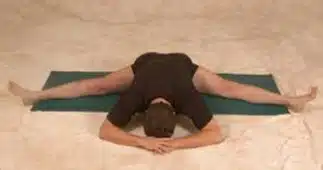Hip openers, you love or loathe them. For example Pigeon Pose is one of those hip openers half of your yoga friends crave for in every yoga class and the other half hates it with fiery passion. I for one love Pigeon Pose, I can relax more in this posture than I do in Downward Facing Dog for example. Hell, I might even enjoy Pigeon Pose more than Savasana! To be honest, my hips were more flexible naturally to begin with, but I still make progress practicing Pigeon Pose and other hip openers. I started to read up on hip openers for my final Yoga Teacher Training assignment last month, and I really like what I learned.
A little something hip related
The hips are attached to the maximum movable synovial joint: the ball and socket. Although this area has the potential to make the most movement, it is often very tight. Stiffness in the hip-area can originate from sitting to much in a chair, but can also be caused by short muscles from cycling or running a lot. Although running and cycling is a healthy habit, the muscles around these joints should be flexible as well, in order to avoid future injuries, improve your posture and help you balance while sitting and standing. Curing or preventing lower back pain is just one of the results practicing hip openers can cause. To be short: practicing hip openers in your yoga class will have well worth long-term benefits!

Example Pigeon Pose, found here
A healthy yoga practice
First we have to realize no body is the same. We are all born with a different blueprint! Although we get stiffer as we grow up, we can only train ourselves as far as our personal bodily blueprint goes. You know, even our own left and right differentiate from each other. Every skeleton is asymmetrical and every skeleton is different. This is one fact you cannot work around. It’s why you might feel more relaxed when you do Pigeon Pose on the left side and maybe your right side never seems to work along in this asana (f.e.). I met a girl who truly is perfect in every posture – she looks like she is made of elastic when I peek at her during practice – but just cannot bend forward when in Butterfly. It is just anatomical. But before you use this as an excuse, we can and should always try to work on the muscles that connect the bones and joints; this is always possible in normal circumstances.
Different hip openers to choose from
A lot of muscles are attached to the hips, you can work 17 to 25 muscles when practicing so called hip openers. Hip muscles are not only situated right on the hip, but start for example already in the lumbar spine (the psoas) and can even involve the quadriceps, all the way to the knees. Every person has a range of different hip openers that are more beneficial for their type of body. Further down you will find a little something on the different groups of muscles and the postures that will help you work them.
Hip openers: mirror to (some of) our emotions
Sitting in a chair all day, cycling or running are not the only reasons hips can be tight. Hips can also be tight because of emotional reasons. On a philosophical and/or spiritual level the hip area is connected to an important chakra: the muladhara chakra or root chakra. Among other things, this chakra is connected to fear, a very basic (but important) human emotion. Also important emotions like sadness, frustration, anxiety and anger can be stored and hold here. Hip openers work on the deep tissues that can release these stressors. So not only these postures release physical as well as emotional tension. On a physiological and hormonal base, hip openers have also a relationship with the fight or flight mechanism, which will be activated when under stress. When we have a lot of tension in the hip area, the psoas – which is connected with this mechanism – is constantly in fight or flight mode and this can mess up all your bodily systems. I can tell you a lot more about this very interesting muscle (and I probably will somewhere in the near future), but for now I will just tell that flexible hips will help you relax the psoas, which is healthy for both mind AND body.
By becoming aware of physical ‘tightness’, you can work on them. This is the first step in releasing your fears. Asana practice will only help you to make this mental change. By loosening up the hips, releasing this tension, your nerve endings can send a message through the spine and to the brain (once the blockage is gone), to stop releasing stress hormones that activate the fight and flight mode. Keep being aware of your prana as well (yogic term that means: universal life force or vital energy) and focus it on the tensed area while in the posture. This energy will warm and soften up the tissue in the hip area, making it easier to relax into a difficult asana in general. Prana enters the body, among other ways, through breathing, so practice a comfortable and steady breath. The area of the muladhara chakra is also a storeroom for this energy and by removing the tightness in your hips you give room for a healthy circulation of prana.

Different hip opening postures for different muscle groups:
- Hip Flexors and quadriceps
Situated: at the hip itself and the front leg
How many muscles in this group: 8 muscles
Which postures can you practice:
– Bridge
– High and low lunge
– Saddle Pose
Aim for feeling the stretch in the whole muscle, rather than at the attachmentpoint. For example, when you mainly feel the stretch in your knees in Saddlepose (picture at the left side), try to reconsider this exercise. Maybe it is too heavy for your knees. You can also start the one-legged variation, in which you start with just one leg and then change to the other. With the leg that is not in saddle pose, you can steady the pelvis and take a bit of pressure of the other knee by holding some of the weight. Also when it is too much for your back, lie on one or two bolsters. If you can easily lie back on your mat, without much stretch in the upper legs at all, you can also place the bolster on top of them. Only consider letting your teacher step on your legs if he or she is qualified and you feel comfortable.
- Hamstrings
Situated: at the back of the leg
How many muscles in this group: not just one muscle as you might think, but existing out of 3 major muscles and 1 minor
Which postures can you practice:
– Downward Facing Dog
– Janu Sirsasana (a seated forward bend, with one foot as close as possible to the groin and knee to the floor)
It is very important never to lower yourself in a posture like Janu Sirsasana, or Sirsasana in general, with a round back. You can bend your knees a bit in order to come down with a straight back.

Downward Facing Dog(s)

Upavishta Konasana, example found here
- Groin, internatl rotators and adductors
Situated: the inside of the leg
How many muscles in this group: 7 muscles
Which postures can you practice:
– Happy Baby (also a very good back massage)
– Butterfly pose (you can use this to warm up in the beginning of your yoga practice, or you can f.e. use it as a final forward bend at the end of the practice)
– Wide legged forward bend (men, I find this difficult)
With the last suggested posture, for example Upavishta Konasana, it is again important that you keep a straight steady back while bending forward. Don’t try to pull yourself to the ground at all costs. Watch for signals like pain in your lower back or at the inside of the knees.
- Gluteal
Situated: on the outer side and back of the hips and bum
How many muscles in this group: 3 gluteals, 3 external rotators and the IT Band (which is a large tendon inside the body)
Which postures can you practice:
– Square pose
– Double Pigeon
– Easy pose
– Lotus pose
Always remember that yoga is about progress and not about reaching some goal as soon as possible. Sometimes good things take time, so don’t force yourself into f.e. Pigeon pose. This will create stress and that’s exactly the opposite effect. Try to enjoy the moment, be proud you once again returned to your yogamat and didn’t go the easy way (no matter how far you came or didn’t came). Try to appreciate your effort, all we have is now. When you practice yoga with love for yourself, you will only grow.

Beautiful Lotus pose, thanks to my friend Kristen